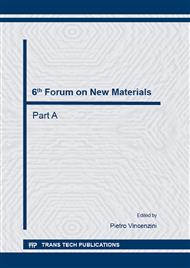p.168
p.174
p.184
p.190
p.196
p.203
p.208
p.219
p.225
Development of High Surface Area Titania on Glass Fibre Supports for Photocatalysis
Abstract:
We show that we have developed a hydrothermal process that produces a high surface area TiO2 on glass fibre supports. The as produced titania shows good photocatalytic activity against a standard commercial dye – Rhodamine B– giving full decolourisation within 3 hours under UV and visible light irradiation. The samples are mechanically robust and can act as a photocatalytic filter for waste streams and pollutants. In addition to testing the standard titania we also photochemically deposit nanostructures of Pd. These hybrid catalysts show enhanced decolourisation by an order of magnitude over the native titania systems. This enhanced performance is due to the increased energy harvesting of the hybrid system through a visible light plasmon interaction and the direct injection of electrons from the noble metal into the adsorbed dye molecules. There is a clear relationship between the absorbed light and photochemical reactivity of the system which is further explained in terms of electron hole generation and separation and plasmonic interaction. In summary, we have generated a high performance catalyst that is produced on a bulk commodity substrate with enhanced activity due to control of the surface plasmon and direct band gap transition of electron hole pairs in the semi-conductor.
Info:
Periodical:
Pages:
196-202
Citation:
Online since:
October 2014
Authors:
Price:
Сopyright:
© 2014 Trans Tech Publications Ltd. All Rights Reserved
Share:
Citation:


